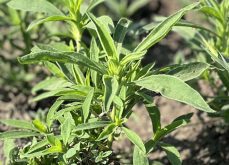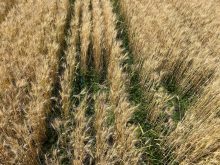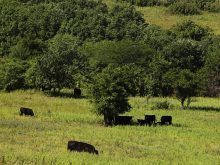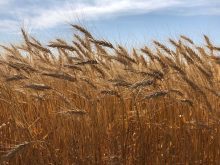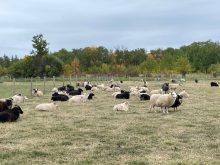“Ergot risk threatens Man., less severe elsewhere.” This title appeared in The Western Producer, Aug. 22, 2024. Let’s put that headline in proper perspective.
For some reason there are agricultural specialists on the Canadian Prairies and in some states who cannot face actual facts. When you have specialists who refer to wheat as a self-pollinated crop and then follow it up with a statement such as “When you have periods of prolonged rainfall that causes the blooms to stay open for longer” — what do they mean? Self-pollinated crops such as wheat, barley and oats, under any normal circumstances, never open their florets prior to seed set.
Rye, on the other hand, has open cross-pollination of the florets, is highly susceptible to ergot infection and can be cross-pollinated by any rye crop that may be growing even up to a mile or more away.
Read Also

Claas brings 1000 Series SP forage harvesters to Canada
In mid-August, Claas unveiled its new line of Jaguar forage harvesters at an event in Visalia, California, deep in the heart of that state’s dairy region.
My colleagues and I at Alberta Agriculture solved the problem of ergot in wheat, barley and oats some 30 years ago. It’s a result of copper, copper, copper deficiency. A lack, or deficiency, of copper results in pollen sterility in these three cereals. Wheat is the most susceptible crop, followed by barley and oats. Rye, to repeat, is always open-flowered and susceptible to ergot infection.
Copper is an essential plant and animal nutrient and in higher plants its primary roles are to provide pollen fertility and stem or branch strength. In wheat, barley and oats, as indicated, copper is responsible for pollen fertility and stem strength in the formation of lignin, the wood-like product that gives cereal straw its rigidity and strength.
A deficiency of copper in a growing crop of wheat, barley or oats results in pollen sterility and lignin formation failure, causing crop lodging. Please read this sentence again.
As a consequence of pollen failure, due to copper absence or deficiency, the normally closed flowers of wheat, barley and oats will not stay closed. The pollen sterility or failure causes the normally closed flower to open up.
Four major results occur, especially in wheat:
- The open flowers can become ergot-infected.
- The open flowers can be cross pollinated by stray wheat, barley or oat pollen from nearby cropland.
- The flowers become blanks — that is, no seed or ergot formation.
- Cereal crops lodge badly because there are no copper enzymes to form lignin — that is, the product that gives the straw strength.
Farmers in Alberta who used to look at low yields, ergot infestations and lodged crops, particularly for wheat and barley, benefitted immensely from my colleagues and I solving this copper deficiency problem over 30 years ago.
Yields of wheat in particular that were often lodged, ergot-infested and given sample grades at 30 bushels an acre went 70-80 bushels of No. 2 or No. 1 annually with an absence of any significant lodging and an absence of ergot. Many cereal growers in the Brandon, MacGregor and Swan River areas of Manitoba followed up on the copper research and reported major yield and quality improvements to my colleagues and myself.

In recent years I have known of significant research funding that has been provided to look for ergot resistance in wheat, lodging in wheat and even a recent five-year trial in North Dakota applying fungicides to ergot-prone wheat fields. The results were a total failure in attempting to control the ergot infections.
I keep hearing of provincial funding for the use of products for the control of lodging in wheat, barley and oats. In these trials, presumably on lodge-prone cropland, there is never a mention of soil copper amendments. That blue powder, copper sulphate at 25 per cent copper, at a rate of around 20-40 lbs. of product (five to 10 lbs. actual copper), could well put an end to crop lodging, ergot infection, low-quality wheat and very depressed yields.
Another factor we identified in Alberta was that certain weed control products, in wheat in particular, would induce severe lodging. We attributed this to, and ultimately identified it as, a herbicide-induced copper deficiency.
I published some 14 papers and fact sheets on this copper issue and many more were published by colleagues. Could it be a case of ‘Don’t confuse me with the actual facts since I have my own opinions’? Together with a couple of colleagues I published a chapter entitled Copper and Plant Disease, in the best-selling book ever by the American Phytopathological Society, Mineral Nutrition and Plant Disease.
The only other known factor causing ergot in both barley and wheat was reported and published by a P. Simojoki in Finland in 1981, when he showed severe boron deficiency caused pollen tube failure in barley, resulting in heavy yield loss and ergot infection. This research was confirmed by Dennis Pageau in Quebec in 1990 in barley growing in soil with less than 0.1 p.p.m. of boron. Prairie soils are rarely, if ever, that deficient in boron.
A footnote
I did write a rebuttal letter to the ergot article that appeared in the Aug. 22, 2024 edition of the Producer. In all my very many years working with cereals I did find a few ergot anomalies.
Very hot dry conditions on oats killed the pollen in the unopened grain. A few days of rain and we had oats with ergots on the opened-out flowers.
A late May frost in Ontario damaged some winter wheat just before the boot stage. The frost killed the pollen cells but not the stigmas. The pollen-free wheat with open flowers now got some ergot infection.
If you are an agronomist involved in agriculture or horticulture in Canada, I would strongly advise you to buy a copy of Horst Marschner’s revised 2022 fourth edition of Mineral Nutrition of Higher Plants. Dr. Ismail Cakmak, a frequent speaker at agronomy meetings in Western Canada, was a major contributor to this revised text.
Japanese wisdom: If it’s not yours, don’t take it. If it’s not right, don’t do it. If it’s not true, don’t say it. If you don’t know, shut up.
Misinformation can hit you hard in the pocketbook.
ALSO: Required reading
To dispel the copper naysayers who inadvertently may be responsible for millions of dollars annually in grain losses, ergot infestations and crop quality, I will list the following references:
- Graham, R.D., 1975. Male sterility in wheat plants deficient in copper. Nature 254: 514-515. This work, done in Australia, showed in cross-pollination experiments the non-viability of copper-deficient pollen and it also showed the continued viability of the ovule. No seed was set from copper-deficient pollen.
- Mantle, P.G. and Swan, D.J., 1995. Effect of male sterility on ergot disease spread in wheat. Plant Pathol. 44: 392-395. Cytoplasmic male-sterile winter wheat grown in England with a limited supply of pollen set over 80 per cent less seed than fertile wheat. Sclerotial mass (ergots) in poorly pollinated male-sterile wheat comprised more that 20 per cent of the threshed grain yield.
- Azourou, Z. and Souvre, A. 1993. Effects of copper deficiency on pollen fertility and nucleic acids in the durum wheat anther. Sex.Plant Reprod. 6: 199-204. This work, done in France, stated that “copper deficiency induced a nearly complete sterility of the pollen formed and inhibited all grain production. In wheat copper deficiency is at the origin of pollen sterility, which results in decreased yields. Boron or molybdenum deficiencies also decrease pollen fertility.”
- Evans, I.R., Huber, D.M. and Solberg, E.D., 2000. Deficiency diseases, pages 295-302 in Encyclopedia of Plant Pathology, Vol. 1. O.C. Meloy and T. D. Murray, eds. Jon Wiley and Sons, New York.
- Copper Deficiency Diagnosis and Correction. 2000, Agdex 532 – 3. Alberta Agriculture website.
- Evans, I.R., Solberg, E.D. and Huber, D.M. Copper and Plant Disease, pages 177-188 in Mineral Nutrition and Plant Disease. Lawrence E. Datnoff, Wade H. Elmer and Don M. Huber, eds. The American Phytopathological Society, second printing, 2009.
- Horst Marschner, 1998. Mineral Nutrition of Higher Plants, Academic Press Inc., San Diego. A92101. The ultimate guru says “Impaired lignification of the cell walls is the most typical change induced by copper deficiency” and “two copper-based enzymes are needed for lignin biosynthesis for stem strength.” The “highest copper content in plants is in the flowers” with “inhibition of pollen release caused by copper deficiency.” “High nitrogen availability can accentuate copper deficiency…” and “foliar application of copper [is needed] for correction of deficiency.”
CORRECTION, Jan. 28, 2025: The print version of this article (Jan. 14, 2025, pgs. 20-21) incorrectly described Dr. Ismail Cakmak as deceased. We regret the error.




